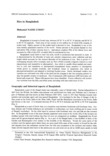Rice in Bangladesh
JIRCAS international symposium series
| ISSN | 13406108 |
|---|---|
| 書誌レコードID(総合目録DB) | AA1100908X |

本文フルテキスト
intlsymp-2_31-41.pdf382.69 KB
Bangladesh is located in South Asia, between 20° 35' N to 26° 75’ N latitude and 88° 03' E to 92° 75', E longitude. Total area of the country is 14.4 million ha of which 62% consists of arable land. Eighty percent of the arable land is devoted to rice. Bangladesh is one of the most densely populated countries of the world. Ninety percent of the people depend on rice and derive 70% of their calories from it. Agriculture employs 70% of the labour force and accounts for 40% of the GDP, of which 20% is contributed by rice.
Bangladesh ranks third in total rice area, fourth in production but sixteenth in yield. It is characterized by the diversity of land, soil, rainfall, temperature, solar radiation and day length which accounts for the varieral diversity of the landraces of rice. Rice is grown in 3 overlapping seasons with 4 ecotypes, such as, Boro which is mostly irrigated, tolerant to cool temperatures and insensitive to photoperiod; Aus which is usually direct-seeded and sensitive to cold and insensitive to photoperiod; transplanted Aman sensitive to photoperiod which grows in rainfed lowlands, and broadcast Aman or deepwater rice which is photoperiod-sensitive and planted in lowlying flooded areas. Newly developed modern rice varieties are cultivated over 50% of the land and the changes in the rice cropping pattern induce the genetic erosion of landraces. Out of estimated 4,000 landraces 3,000 have been collected and conserved. Three wild species have been identified. Future collection will involve rice varieties from the hilly and tribal areas, including wild and weed races of rice.
Bangladesh ranks third in total rice area, fourth in production but sixteenth in yield. It is characterized by the diversity of land, soil, rainfall, temperature, solar radiation and day length which accounts for the varieral diversity of the landraces of rice. Rice is grown in 3 overlapping seasons with 4 ecotypes, such as, Boro which is mostly irrigated, tolerant to cool temperatures and insensitive to photoperiod; Aus which is usually direct-seeded and sensitive to cold and insensitive to photoperiod; transplanted Aman sensitive to photoperiod which grows in rainfed lowlands, and broadcast Aman or deepwater rice which is photoperiod-sensitive and planted in lowlying flooded areas. Newly developed modern rice varieties are cultivated over 50% of the land and the changes in the rice cropping pattern induce the genetic erosion of landraces. Out of estimated 4,000 landraces 3,000 have been collected and conserved. Three wild species have been identified. Future collection will involve rice varieties from the hilly and tribal areas, including wild and weed races of rice.
| 作成者 | Muhamad NASIR UDDIN |
|---|---|
| 公開者 | Japan International Research Center for Agricultural Sciences |
| オンライン掲載日 | |
| 号 | 2 |
| 開始ページ | 31 |
| 終了ページ | 41 |
| 言語 | eng |
